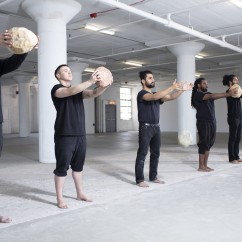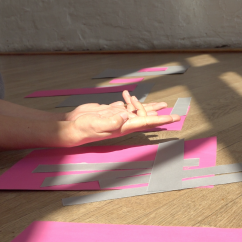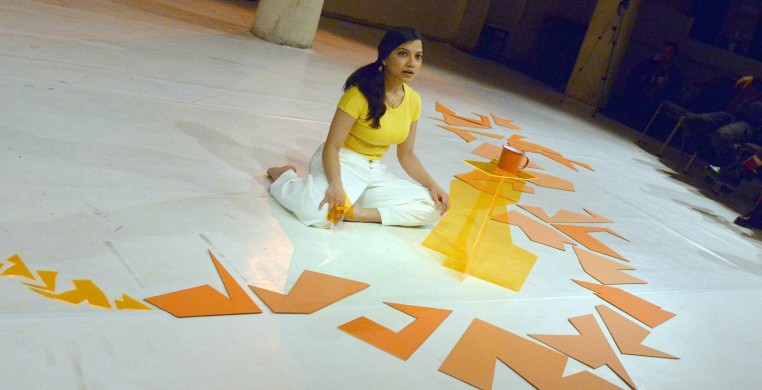From September 7-10, The Museum of Contemporary Art Chicago presents “Chicago Performs 2023.” The performing arts festival gives emerging artists entering a new phase of their practice an opportunity to explore new ideas and directions, expand their scale of work, and reimagine their art in a new space and for new audiences.
This year’s cohort of artists include Jonas Becker, focusing on the slow degradation of societal conditions that go unnoticed over time; Anjal Chande, exploring the narratives we have about ourselves and how that shapes identity; and Irene Hsiao, who asks us to reexamine what our norms are around interacting with people and things within our environment.
The performance residency chooses work at various stages of development. The MCA’s goal is to nurture the creative process of these artists so that they may achieve an artistic freedom not possible without a collaboration with larger institution. “The MCA makes a point of actively going out and seeing what work artists are making across different types of disciplines,” said Curatorial Associate, Laura Paige Kyber. "The arc of the life of a performance is quite long and spends it’s time in many phases of process. What we see on stage is just a blip along that arc.”
By providing rehearsal space, a large stage and access to the MCA’s wide audience base, Kyber expresses a passionate interest in the exciting ways these artists’ work will evolve with proper support. “The ephemeral nature of a living work always in process is exciting!”
Becker’s “New Normal” is an iterative work for space and stage performed by six transmasculine performers, and centers around eight “gestures” that focus on concepts like care and aggression—imagine the six atop flat boards balanced over rocks, like floating in space, while singing Madonna’s “Like a Prayer”—or endurance and illusion—picture all bodies in a line holding large rocks and dopey smiles plastered on their faces. (What is harder to hold, an object or an emotion?)
“The eight gestures are endurance based,” said Becker. “It’s primarily the audience watching a cast of six people negotiate these different movements and how they make decisions around different actions.”
 Jonas Becker's "The New Normal," a work of physical and emotional endurance.
Jonas Becker's "The New Normal," a work of physical and emotional endurance.
The theme revolves around how the body processes slow and steady masculine cultural trauma. “’New Normal’ is based on the idea of a shifting baseline,” said Becker. “Society, politics and the environment are constantly shifting. What we expect from them also shifts. As that baseline shifts slowly over time people typically adjust, not realizing that these slow changes can be harmful.” With the rise in popularity of hyper-masculine social media influencers advocating for male supremacy and celebrating violence against both men and women, Becker’s message is especially crucial.
Anjal Chande’s “The Next Cup of Tea” uses improvised dance, spoken word, humming, pedestrian movement and colorful polygonal props to braid together narratives to reckon with life within a Capitalist, neocolonial society that focuses on the accumulation of wealth over humanity. Chande cites her grandfather as inspiration, particularly his “anti-Capitalist tendencies”— taking time, moving slowly, sitting still, hosting 5 o’clock teatimes where the family can be together.
Chande views the world and the work through the unique lens of being an Indian American, using her training in the Southern Indian dance form of Bharatanatyam to communicate her message of self-reflection and self-care. “People more familiar with Bharatanatyam will find a residue of that,” said Chande, “but the endeavor is to find one’s own inner voice and freedom within mechanic mechanisms.”
The decor is intricately planned. The seating of the audience, shapes in Chande’s body and the mudras in her hands are mirrored by various polygonal props, what Chande calls “kaleidoscopic intangibles.” “These mundane objects take on multiple symbolic meanings,” said Chande, “like how a gnawing thought can take a shape in the imagination, a thing that can be objectified, looked at and deciphered.”
 Polygons mirror a mudra in Anjal Chande's "The Next Cup of Tea."
Polygons mirror a mudra in Anjal Chande's "The Next Cup of Tea."
Chande takes an honest look at how we wrestle with our interior world, chewing on our contradictions, while being adrift in a material world. “The act of miming the act of making tea is an anchor point in one’s daily life, the returning to the same glass everyday becomes a container for holding all one’s inner thoughts and feelings.” Chande’s message of slowing down is a salubrious antithesis to the anxiety produced by living in a world where communication and media move ever faster.
Irene Hsiao draws inspiration from visual art—architecture and textile materials—to create the alternate persona, “Blue Alice.” In a costume designed by Vin Reed, “Blue Alice” dresses from the neck down in form fitting, shiny and silvery mylar surrounded by a very large skirt made of navy-blue tarp. Hsiao describes the costume as “A shining, ever-changing surface with the sound like a monsoon or an ocean.”
When Hsiao was invited by the Ragdale Foundation to develop the initial concept during an architecture competition, she used the half-built structures and scattered building materials—including the tarps they were packaged in—as inspiration. This process of improvised creation extends to the performance itself, with Hsiao altering the work based on location and who is in attendance. “The work changes every time depending on where it is and who is there with ‘her,’” said Hsiao. “Because it’s very material driven, the dress talks first.”
 Irene Hsiao as "Blue Alice" at the MCA; Photo by Jeremy Lawson
Irene Hsiao as "Blue Alice" at the MCA; Photo by Jeremy Lawson
“Blue Alice” is a shapeshifter, only limited by Hsiao’s and the audience’s imagination. In a previous performance of the work at the 21c Museum Hotel, Hsiao transformed the large skirt into a hulking, primordial creature. She then emerges from the circular opening in the center like an astronaut floating through a narrow airlock. Later, she blooms like a giant flower, a futuristic “Audrey” from “Little Shop of Horrors.” That’s all just scratching the surface of Hsiao’s mutable transformations.
For Hsiao, “Blue Alice” blurs the separation between art and artist—“I began to think of this abstract work as a human.” Who’s more real, Hsiao or “Alice?” “I don’t know!” exclaims Hsiao. “I don’t know if ‘Blue Alice’ is me or not!”
This year’s cohort of artists invites audiences to pause, take a breath, slow down, examine the conditions around them, and to reflect on what those conditions really are. Far from your average art museum, “Chicago Performs 2023” embodies the MCA’s mission to offer the opportunity to experience the work of living artists who create work that reflects the social and cultural context of our time.
“Chicago Performs 2023” runs from Sept. 7-10 at the Museum of Contemporary Art Chicago, 220 E Chicago Ave. Performance times vary, and tickets can be found by clicking on the event link here.

